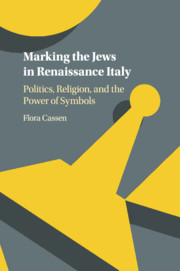
- Cited by 6
-
Cited byCrossref Citations
This Book has been cited by the following publications. This list is generated based on data provided by Crossref.
Rasmussen, Ann Marie and van Asperen, Hanneke 2018. Introduction: Medieval Badges. The Mediaeval Journal, Vol. 8, Issue. 1, p. 1.
Fischer, Susan L. 2022. Which Is the ‘Jew / That Shakespeare Drew’? Shylock’s Afterlife in Mere Reading and Maverick Stagings. Shakespeare, Vol. 18, Issue. 1, p. 139.
Kinoshita, Ken 2023. Japanese Politicians’ Rhetorical and Indirect Speech. p. 185.
Galai, Yoav 2023. Political Visual Literacy. International Political Sociology, Vol. 17, Issue. 3,
Aust, Cornelia 2023. The Afterlife of Early Modern Images of Jews. TEXTILE, Vol. 21, Issue. 3, p. 772.
Terpstra, Nicholas 2024. Senses of Space in the Early Modern World.
- Publisher:
- Cambridge University Press
- Online publication date:
- July 2017
- Print publication year:
- 2017
- Online ISBN:
- 9781316798492
- Subjects:
- Judaism, Area Studies, European History after 1450, History, Religion, European Studies




